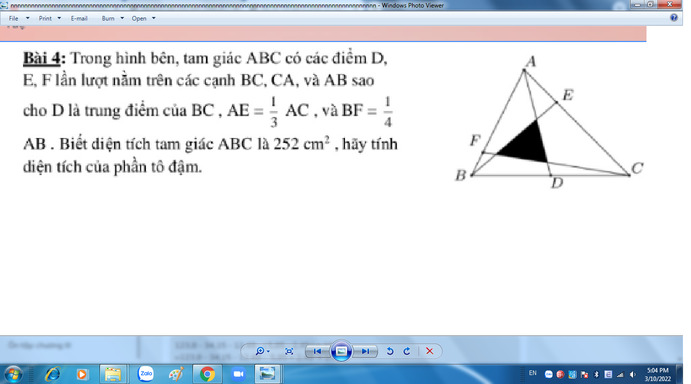
Hãy nhập câu hỏi của bạn vào đây, nếu là tài khoản VIP, bạn sẽ được ưu tiên trả lời.


Bài 1:
Vận tốc cano khi dòng nước lặng là: $25-2=23$ (km/h)
Bài 2:
Đổi 1 giờ 48 phút = 1,8 giờ
Độ dài quãng đường AB: $1,8\times 25=45$ (km)
Vận tốc ngược dòng là: $25-2,5-2,5=20$ (km/h)
Cano ngược dòng từ B về A hết:
$45:20=2,25$ giờ = 2 giờ 15 phút.

Bài 1:
a.
$a^3-a^2c+a^2b-abc=a^2(a-c)+ab(a-c)$
$=(a-c)(a^2+ab)=(a-c)a(a+b)=a(a-c)(a+b)$
b.
$(x^2+1)^2-4x^2=(x^2+1)^2-(2x)^2=(x^2+1-2x)(x^2+1+2x)$
$=(x-1)^2(x+1)^2$
c.
$x^2-10x-9y^2+25=(x^2-10x+25)-9y^2$
$=(x-5)^2-(3y)^2=(x-5-3y)(x-5+3y)$
d.
$4x^2-36x+56=4(x^2-9x+14)=4(x^2-2x-7x+14)$
$=4[x(x-2)-7(x-2)]=4(x-2)(x-7)$
Bài 2:
a. $(3x+4)^2-(3x-1)(3x+1)=49$
$\Leftrightarrow (3x+4)^2-[(3x)^2-1]=49$
$\Leftrightarrow (3x+4)^2-(3x)^2=48$
$\Leftrightarrow (3x+4-3x)(3x+4+3x)=48$
$\Leftrightarrow 4(6x+4)=48$
$\Leftrightarrow 6x+4=12$
$\Leftrightarrow 6x=8$
$\Leftrightarrow x=\frac{4}{3}$
b. $x^2-4x+4=9(x-2)$
$\Leftrightarrow (x-2)^2=9(x-2)$
$\Leftrightarrow (x-2)(x-2-9)=0$
$\Leftrightarrow (x-2)(x-11)=0$
$\Leftrightarrow x-2=0$ hoặc $x-11=0$
$\Leftrightarrow x=2$ hoặc $x=11$
c.
$x^2-25=3x-15$
$\Leftrightarrow (x-5)(x+5)=3(x-5)$
$\Leftrightarrow (x-5)(x+5-3)=0$
$\Leftrightarrow (x-5)(x+2)=0$
$\Leftrightarrow x-5=0$ hoặc $x+2=0$
$\Leftrightarrow x=5$ hoặc $x=-2$


Câu 4:
a: ĐKXĐ: \(x\notin\left\{0;-5\right\}\)
b: \(A=\dfrac{x^2+2x}{2\left(x+5\right)}+\dfrac{x-5}{x}+\dfrac{50-5x}{2x\left(x+5\right)}\)
\(=\dfrac{x^3+2x^2}{2x\left(x+5\right)}+\dfrac{2\left(x^2-25\right)}{2x\left(x+5\right)}+\dfrac{50-5x}{2x\left(x+5\right)}\)
\(=\dfrac{x^3+2x^2+2x^2-50+50-5x}{2x\left(x+5\right)}\)
\(=\dfrac{x^3+4x^2-5x}{2x\left(x+5\right)}=\dfrac{x\left(x^2+4x-5\right)}{2x\left(x+5\right)}\)
\(=\dfrac{x\left(x+5\right)\left(x-1\right)}{2x\left(x+5\right)}=\dfrac{x-1}{2}\)
c: Để A=-3 thì x-1=-6
hay x=-5(loại)

Điều kiện:
\(x-1\ne0\Rightarrow x\ne1\)
\(x^3+x\ne0\Leftrightarrow x\ne0\)

Ta có: \(\left(x-1\right)^2\ge0\) \(\Leftrightarrow x^2-2x+1\ge0\)\(\Leftrightarrow x^2+1\ge2x\).\(\left(1\right)\)
\(\left(y-2\right)^2\ge0\Leftrightarrow y^2-4y+4\ge0\Leftrightarrow x^2+4\ge4y\).\(\left(2\right)\)
\(\left(z^2-9\right)\ge0\Leftrightarrow z^2-6z+9\ge0\Leftrightarrow z^2+9\ge6z\).\(\left(3\right)\)
Từ \(\left(1\right),\left(2\right)\)và \(\left(3\right)\) nhân vế theo vế ta được:
\(\left(x^2+1\right).\left(y^2+4\right).\left(z^2+9\right)\ge48xyz\)
mà theo đề ta có:\(\left(x^2+1\right).\left(y^2+4\right).\left(z^2+9\right)=48xyz\)
nên \(\left\{{}\begin{matrix}x^2+1=2x\\y^2+4=4y\\z^2+9=6z\end{matrix}\right.\)
\(\Leftrightarrow\left\{{}\begin{matrix}x=1\\y=2\\z=3\end{matrix}\right.\)
Thay \(x=1;y=2;z=3\)vào biểu thức A ta được:
\(A=\dfrac{x^3+y^3+z^3}{\left(x+y+z\right)^2}=\dfrac{1+8+27}{\left(1+2+3\right)^2}=1\)
Vậy giá trị của biểu thức \(A=\dfrac{x^3+y^3+z^3}{\left(x+y+z\right)^2}\)là 1.

a)x^2+5y^2+2x-4xy-10y+14
=x^2+2x-4xy+5y^2-10y+14
=x^2+2x(1-2y)+5y^2=10y+14
=x^2+2x(1-2y)+(1-2y)^2+5y^2-10xy-(1=2y)^2+14
=(x+1-2y)^2+5y^2-10y-(1-4y+4y^2)+14
=(x+1-2y)^2+5y^2-10y-1+4y-4y^2+14
=(x+1-2y)^2+y^2-6y+13
=(x+1-2y)^2+(y-3)^2+4
Vì....(đpcm)
b)5x^2+10y^2-6xy-4x-2y+3
=(x^2-6xy+9y^2)+(4x^2+1-4x)+(y^2-2y+1)+1
=(x-3y)^2+(2x-1)^2+(y-1)2+1
Vì....
(đpcm)





 giúp mk nha mờn nhìu ạk
giúp mk nha mờn nhìu ạk









 Mọi Người giải giúp em ạ em cảm ơn ạ
Mọi Người giải giúp em ạ em cảm ơn ạ 
 Help me
Help me
\(a,=x^3+2x^2-x-2-x^3+8=2x^2-x+6\\ b,=\dfrac{\left(x-2y\right)\left(x+2y\right)}{2\left(x-2y\right)}=\dfrac{x+2y}{2}\\ c,=\dfrac{4xy+x^2-2xy+y^2}{2\left(x-y\right)\left(x+y\right)}\cdot\dfrac{2x}{x+y}-\dfrac{y}{x-y}\\ =\dfrac{x\left(x+y\right)^2}{\left(x-y\right)\left(x+y\right)^2}-\dfrac{y}{x-y}=\dfrac{x}{x-y}-\dfrac{y}{x-y}=1\)